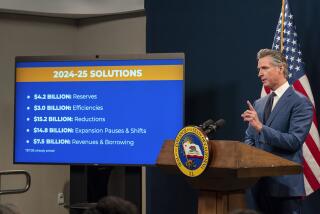Gov. Jerry Brown to propose billions in new spending
SACRAMENTO â When he unveils his new budget plan Thursday, Gov. Jerry Brown will propose billions of dollars in new spending on schools, healthcare, social services and environmental programs as California reaps the benefits of an economic turnaround.
The governorâs $155-billion blueprint would increase general-fund spending by more than 8%, to $106.8 billion. Brown also wants to repay $11 billion in debts incurred during years of state financial crisis, and he would stash $1.6 billion in a reserve fund as a buffer against future economic turmoil.
âWisdom and prudence should be the order of the day,â Brown wrote in an introductory message to his 271-page plan, which was leaked ahead of his official announcement, originally scheduled for Friday.
The document is also stuffed with far-reaching policy prescriptions, some likely to draw controversy. Brown wants to make it easier for local governments to issue bonds to pay for public-works projects, and he has reversed his opposition to releasing some elderly, sick and other low-risk inmates to help meet court-ordered limits on the state prison population.
Budget negotiations over the next several months will be crucial for Brown as he lays the groundwork for his expected reelection campaign. Lawmakers must pass a spending plan by June 15 so it can be signed into law and enacted by July1.
The governor has tried to maintain financial restraint even while acknowledging calls from unions and activists who want him to loosen the purse strings after years of deep cuts to social services and other government programs.
Brown ran for office in 2010 with a pledge to repair Californiaâs faltering finances, which had become a national punch line. The governor persuaded voters to approve temporary tax hikes in 2012, and he has benefited from the stateâs recovering economy.
Administration officials now expect a $4.2-billion surplus by the end of June â as opposed to the $26.6-billion deficit Brown encountered when he took office in 2011.
The bulk of new money would go to schools and community colleges, which are poised to receive $10 billion more through the stateâs education funding formula. Some of that money was withheld in recent years as officials struggled to balance the budget.
The governor will propose $1 billion more for higher education, in part to stave off the kind of tuition increases forced on students during the financial crisis. Brown will also continue prodding the University of California and California State University systems to improve graduation rates by dangling the possibility of $50 million in additional funding.
The proposed budget includes $670 million more for Medi-Cal, the stateâs public healthcare program, which is expanding as part of President Obamaâs federal overhaul. The program is expected to serve a quarter of Californiaâs residents next year.
Assembly Speaker John A. Pérez (D-Los Angeles) said in a statement that he was âpleased to see so many areas of agreementâ between the governor and his caucus.
He emphasized Brownâs support of a new rainy day fund, which Pérez said would allow the state to âavoid mistakes of the past and ensure that education and other vital services in California are protected from the volatility of boom and bust cycles.â
The governor favors a November ballot measure that would siphon off some tax revenue and channel it into a special savings account.
A top item on Democratsâ wish list â universal preschool for 4-year-olds in California â is not included in the governorâs plan. Neither does Brown propose restoring some money cut from healthcare providers who participate in Medi-Cal.
In his budget document, Brown notes there are financial challenges still on the horizon. Retirement benefits for public employees are underfunded by $218 billion, according to administration estimates, and the state has billions of dollars in other outstanding obligations and debts.
In particular, the account dedicated to teachersâ pensions is short $80.4 billion. Instead of filling that hole, Brown calls for âa new funding strategyâ to force teachers, school districts and the state to chip in more down the line.
Some of the additional spending in Brownâs proposal was planned for in the current budget, which expires June 30. The governor agreed last year to lawmakersâ requests to phase in higher funding for social services, healthcare and education. For example, welfare checks are scheduled for a 5% boost, at a cost of $168 million. Tuition assistance at California universities would increase by $107 million.
Brown also proposes tapping $850 million generated by new fees on polluters, much of it to be spent on such items as energy-efficiency projects, wetlands restoration and rebates for Californians who buy cleaner cars. He is also making a controversial proposal to use $250 million to bolster financing for the troubled statewide high-speed rail project.
In the budget document, Brown supports legislation that would make it easier for local governments to issue bonds for public works projects, lowering the threshold for voter approval to 55%. Most local bonds and tax hikes now require a two-thirds vote.
One wild card in Brownâs plans is the legal battle over crowding in California prisons. The governor acknowledges the state is falling short of court-ordered limits on the prison population, and heâs counting on federal judges to grant him an additional two years to hit the target.
In the meantime, Brown will allow more releases of prisoners who are elderly or in seriously ill health, and appears willing to shorten the sentences of some nonviolent offenders who participate in rehabilitation programs and have behaved well behind bars â moves he previously resisted.
If the deadline for meeting the inmate cap is not extended, Brown plans to spend $315 million to house thousands of prisoners in private lockups.
Times staff writers Melanie Mason, Patrick McGreevy and Paige St. John contributed to this report.
More to Read
Sign up for Essential California
The most important California stories and recommendations in your inbox every morning.
You may occasionally receive promotional content from the Los Angeles Times.











